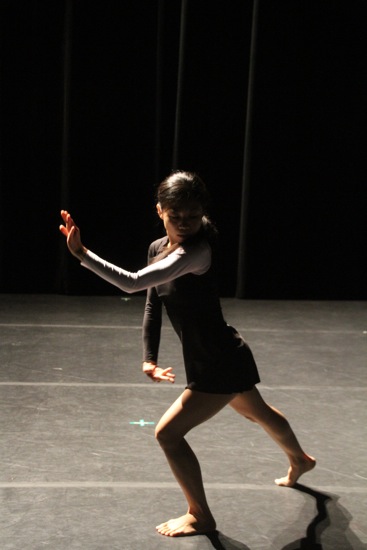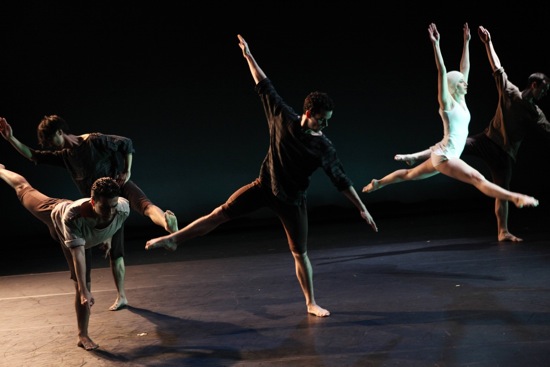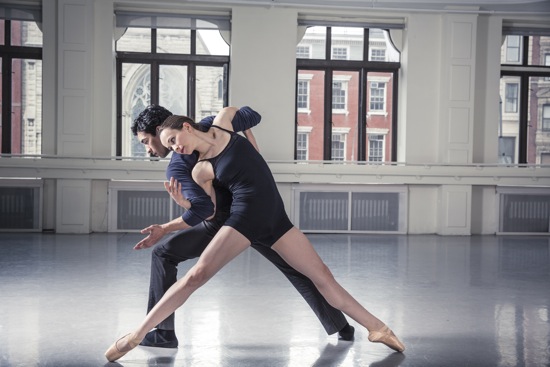Zvi Gotheiner, Cherylyn Lavagnino, and Dusan Tynek share a series at the Baruch Performing Arts Center, June 12 through 22.
I should have sat down at the computer right after getting home from the opening of Musa! A Festival of Dance with Music at Baruch Performing Arts Center. The inaugural performance was so dense with dancing that keeping my memories of it intact has been a challenge. Also, although the remaining programs in this series (produced by Philip W. Sandstrom and Equilateral Theatre Inc.) showcase no more than three dances apiece, the first one featured five, plus one intermission, two long pauses, and a lighting glitch that necessitated fixing.
From June 12 through 22, Musa! is presenting choreography by Zvi Gotheiner, Cherylyn Lavagnino, and Dusan Tynek in solo or shared programs. All three create pieces rich in dancing and musically sensitive, and they craft their dances expertly—no maelstroms of limber creatures hurtling around without discernible reason. All are inventive, although none ventures into dangerously risky territory, unless you count Lavagnino’s imaginative manipulation of ballet conventions.
Gotheiner’s Sky and Water (a world premiere), set to an excellent original score by Scott Killian, alludes to its title primarily though patterns and rhythms. The choreography was inspired by the art of M.C. Escher, with its whirlpools, helixes, and parallel ranks. At the outset, the dancers accumulate on stage, gradually building power like a tide. Kuan Hui Chew begins alone, calmly and fluidly articulating her flexible body. Like all the dancers, she wears a short, black outfit with one white sleeve (costumes by Reid Bartelme). By the time seven others have entered and fit into the ongoing pattern that Chew has established, they’re ready to break into four-part counterpoint, and then magically reassemble into two lines of four. After Nicole Marie Smith and Nathan Coder have danced close together in a silent, undulating conversation that bubbles around the sounds of a piano, they separate into a canon to pursue identical thoughts at different times.
Gotheiner also plays with the notion of replacement. Chew, William Tomaskovic, Smith, and Ying-Ying Shau move within a tightly squared constellation. Then Alison Clancy replaces Chew, two others replace Chau and Smith, and those evicted form their own trio off to the side. Later everyone orbits around Clancy, who is succeeded by others in tiny solo displays. In contrast to the big space-covering passages, there are more constrained ones—such as the little episode when two lines of people sit shoulder-to-shoulder on the floor, their legs stuck out in front of them, and make little twitchy moves.
Brief duets carry on the idea of fitting, or not fitting into someone else’s patterns and rhythms—one encounter for Chew and David Norsworthy, one for Todd Allen and Chelsea Ainsworth. Some passages in Sky and Water, seem slightly contrived, but the interplay of forces can be exhilarating. A nice surprise: Clancy and Allen have been dancing separately but simultaneously for a few moments, and, just as the lights go out, she whispers something in his ear.
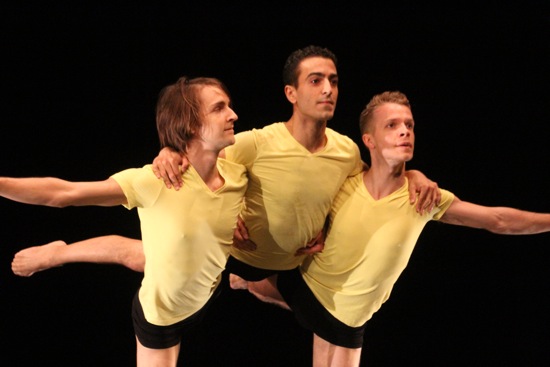
L to R: Timothy Ward, John Eirich, and Ned Sturgis in Dusan Tynek’s Apian Way. Photo: Phyllis McCabe
Dusan Tynek’s 2008 Apian Way (excerpted for this performance) also enters the world of natural forms. Note the single “p.” This is no exploration of an ancient Roman thoroughfare; it’s a reference to the busy world of bees. The very musical choreographer has chosen a very different world of intricate alliances for his score: four movements drawn from two of J.S. Bach’s sonatas for violin (Nos. 1 and 3) and the Sarabande from Partita No. 1. The opening Presto for six dancers is a buzz of traffic: rushing, leaping people travel at different speeds—their paths curving, merging, intersecting. Groups cluster as if to converse, flapping their arms and making little flicking gestures with their hands.
The Adagio of Apian Way features the four women of Dusan Tynek Dance Theatre (DT)2 (Alexandra Berger, Ann Chiaverini, Emily Gayeski, and Elisa Osborne) rearranging themselves quietly together. The Sarabande is a duet for Chiaverini and Samuel Swanton. Suddenly Roderick Murray’s lights practically explode into noontide brightness, and John Eirich, Ned Sturgis, and Timothy Ward perform an exuberant trio. If these are the drones of the hive, they manage a terrific display of testosterone-fueled competiveness and athletic camaraderie (to Bach’s Allegro Assai) before their designated mating flight.
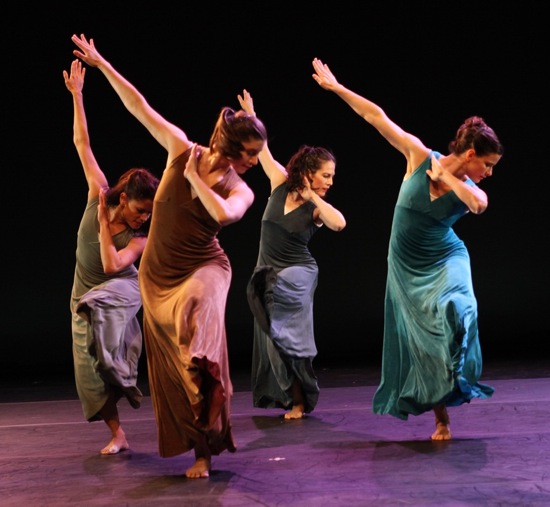
L to R: Elisa Osborne, Ann Chiaverini, Alexandra Berger, and Emily Gayeski in Dusan Tynek’s Widow’s Walk. Photo: Julieta Cervantes
Tynek’s 2011 Widow’s Walk closes the program with very different music, all recorded by ETHEL: Lennie Tristano’s 1955 Requiem (arranged in 2006 by Mary Rowell), The Blue Room: March (2002), and The Blue Room: Tarantella—both these last by Phil Kline. As the program makes clear, the title refers to the railed, rooftop structures on 19th century houses along the New England coast. There, the wives of sailors would walk, gazing out to the sea from which their loved ones might, or might not return.
In Tynek’s beautiful piece, we see four women in long gowns, pacing with deep, bent-forward lunges around and around in a square. We see the men dance energetically—pausing now and then to point their fingers in different directions. And we see couples enjoying themselves in the happy times when they were together; their steps are vigorous, like those in a folk dance. The middle section takes a turn toward abstraction. To Kline’s steady rhythm, the men start a pressured walking from one side of the stage to the other. But, hopping on one leg with the other lifted behind them, they keep being forced back by the unseen tide. One man may move forward, while another, driven back, passes him. Each manages a separate struggle within the same tide.
But as they do this, the four women, now wearing white bathing costumes and caps (costumes by Anna-Elisa Belous), leap among them, leap past them, disappear, rush through again. You can imagine them as the foam tossed up among the gradually slowing men. In another section the men struggle together, holding onto one another, pulling apart and together, lifting one of them high. As if the memories (and the weather) have become impossibly turbulent, the women—wearing their gowns again, but with their hair loose—race on and off the stage, as do the men, now without their shirts. Sometimes a woman snags on a man and is picked up and carried off; sometimes she dives onto him. The pace never slows; the stage is a whirlpool, the strings in the music raging. In the end, the women are back to their memories, their dreams, and their lonely pacing.
I greatly admire how warmly Tynek’s dancers respond to one another and the space around That’s also true of Ramona Kelley and Justin Flores in Compadre, one of two works by Cherylyn Lavagnino that appeared between Tynek’s Apian Way and Widow’s Walk. While accordionist JP Joffre and pianist Evelyn Ulex, playing live, whip into Astor Piazzola’s piece of the same name, Kelley and Flores flirt and dance with a peppery fervor. They’re charming together in this tango encounter that’s performed in pointe shoes rather than high heels. The dancers in two movements excerpted from Lavagnino’s Treize en Jeu are less aware of one another (at least, that was true on opening night). Of the five couples that perform brief duets, Giovanna Gamna and Michael D. Gonzalez were the most acutely attentive to each other.
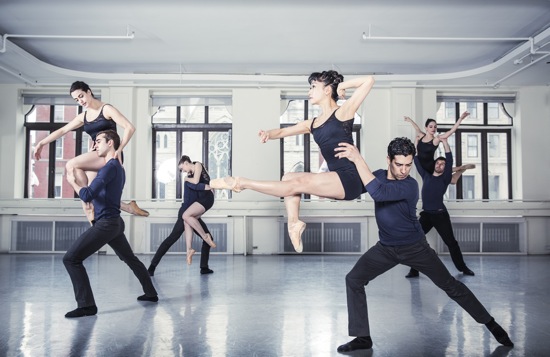
L to R: Claire Westby with Samuel Swanton, Christine Luciano with Eric Williams, Selena Chau with Justin Flores, Ramona Kelley with Adrian Silver in Cherylyn Lavagnino’s Treize en Jeu. Rehearsal photo: Travis McGee
Treize en Jeu marked the musical high point of the evening. It’s set to Franz Schubert’s luscious Trio in E-flat major D 929 (Op. 100), and the score was played live by Jane Chung (violin), Sarah Biber (cello), and Andrea Lam (piano). Lavagnino’s choreography captures the music’s 19th-century romanticism by molding ballet steps to convey moods and relationships, without the manners that are integral to the classical repertory and without the deliberate deformations that some contemporary ballet choreographers visit upon the traditional steps. Her duets—athletic, playful, or tender—don’t resemble the usual pas de deux; they erupt from the flow of dancing and slip into intimacy without fanfare or sentimentality. The women are strong as well as elegant and use their pointe shoes primarily as extensions of their feet, rather than as platforms to be pounced onto. Both men and women slip down to the floor as easily as they soar into the air.
The choreography deploys the thirteen dancers in pleasing, overlapping patterns—the women in sleek black leotards, the men in dark shirts and trousers (costumes: Rabiah Troncelliti). You can imagine a party going on somewhere out of our sight; people just breeze onto the stage, pause for some interchanges, and depart to listen to the music and have a glass of wine. Some occasionally assemble in little, informal background choruses.
The dancers are also more diverse than those in a large ballet company. It’s stimulating to watch Clare Westby with Eric Williams, Laura Mead with Justin Flores, Christine Luciano with Samuel Swanton, Kelley with Adrian Silver, Gamna with Gonzalez, Flores with Chau, plus Kristin Diess and Jackie McConnell. There’s no confusing one with another; discipline doesn’t mask individuality.
The basement theater in Baruch College is a sizeable, serviceable, high-ceilinged black box, with a performing area shallower than its width would suggest and little wing space. Still, all three choreographers made excellent use of what the stage offered. The lighting designers—Kathy Kaufmann for Lavagnino, Mark London for Gotheiner, and Murray for Tynek—also managed fine effects with what seemed like a relatively modest amount of equipment. Yes, the opening night program was heavy— freighted with big, musical, full-bodied dancing— but beauty abounded.

